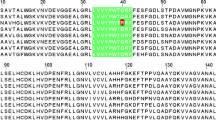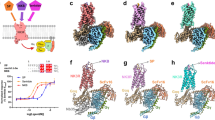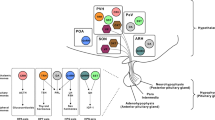Abstract
A SERIES of peptides with morphine-like activity has been identified in extracts of pituitary1–3 and brain4–7. With the exception of Leu-enkephalin, all those characterised represent some fraction of the 31-residue C fragment—a specific activation product of lipotropin1,8. Several attempts have been made to define the receptor requirements of opiate peptides9,10 and to make potent and stable agonists5,11,12, but essentially all the studies have been based on the easily synthesised NH2-terminal pentapeptide of C fragment, Met-enkephalin. Unlike the enkephalins, C fragment has a high potency in its central actions13–16, in vivo and in vitro, and it is relatively stable to brain peptidases17–19. C fragment is the only naturally occurring peptide to possess strong analgesic properties and have a long lasting action20. It is clear that specific regions of the molecular structure, not present in γ and α endrophin or Met-enkephalin, have a role in the expression of its central activity. We present here evidence that the COOH-terminal tetrapeptide of C fragment, Lys-Lys-Gly-Gln, is responsible for the unique affinity of C fragment for brain opiate receptors and that the presence of all four residues is essential for the high analgesic potency.
This is a preview of subscription content, access via your institution
Access options
Subscribe to this journal
Receive 51 print issues and online access
$199.00 per year
only $3.90 per issue
Buy this article
- Purchase on Springer Link
- Instant access to full article PDF
Prices may be subject to local taxes which are calculated during checkout
Similar content being viewed by others
References
Bradbury, A. F., Smyth, D. G. & Snell, C. R. in Peptides: Chemistry, Structure and Biology (eds Walter, R. & Meinhofer, J.) 609–615 (Science, Ann Arbor, 1975).
Bradbury, A. F., Smyth, D. G. & Snell, C. R. in Polypeptide Hormones: Molecular and Cellular Aspects, CIBA Found. Symp. No. 41, 61–75, (Elsevier–North Holland, Amsterdam 1976).
Graf, L., Barat, E. & Patty, A. Acta Biochem. biophys. Acad. Sci. Hung. 11, 111 (1976).
Hughes, J. et al. Nature 258, 577–579 (1975).
Bradbury, A. F., Feldberg, W. S., Smyth, D. G. & Snell, C. R. in Opiates and Endogenous Opioid Peptides (ed. Kosterlitz, H. W.) 9–17 (Elsevier–North Holland, Amsterdam, 1976).
Simantov, R. & Snyder, S. H. Proc. natn. Acad. Sci. U.S.A. 73, 2515–2519 (1976).
Guillemin, R., Ling, N. & Burgus, R. C. r. hebd. Séanc. Acad. Sci., Paris SD. 282, 783–785 (1976).
Bradbury, A. F., Smyth, D. G. & Snell, C. R. Biochem. biophys. Res. Commun., 69, 950–956 (1976).
Bradbury, A. F., Smyth, D. G., Snell, C. R., Birdsall, N. J. M. & Hulme, E. C. Nature 260, 793–795 (1976).
Lazarus, L. H., Ling, N. & Guillemin, R. Proc. natn. Acad. Sci. U.S.A. 73, 2156–2159 (1976).
Pert, C. B., Bowie, D. L., Fong, F. T. W. & Chang, J. K. in Opiates and Endogenous Opioid Peptides (ed. Kosterlitz, H. W.) 79–86 (Elsevier–North Holland, Amsterdam, 1976).
Coy, D. H. et al. Biochem. biophys. Res. Commun. 73, 632–638 (1976).
Feldberg, W. S. & Smyth, D. G. J. Physiol., Lond. 260, 30–31P (1976); 265, 25–27P (1977).
Loh, H. H., Tseng, L. F., Wei, E. & Li, C. H. Proc. natn. Acad. Sci. U.S.A. 73, 2895–2898 (1976).
Bradbury, A. F., Smyth, D. G., Snell, C. R., Deakin, J. F. W. & Wendlandt, S. Biochem. biophys. Res. Commun. 74, 748–754 (1977).
Gent, J. P., Smyth, D. G., Snell, C. R. & Wolstencroft, J. H. J. Pharmac. (in the press).
Austen, B. M. & Smyth, D. G. Biochem. biophys. Res. Commun. 76, 477–482 (1977).
Geisow, M. J. & Smyth, D. G. Biochem. biophys. Res. Commun. 75, 625–629 (1977).
Austen, B. M., Smyth, D. G. & Snell, C. R. Nature (submitted for publication.)
Feldberg, W. S. & Smyth, D. G. Br. J. Pharmac. 60, 445–454 (1977).
d'Amour, F. E. & Smith, D. L. J. Pharmac. exp. Ther. 72, 74–79 (1941).
Belluzi, J. D. et al. Nature 260, 625–626 (1976).
Büscher, H. H. et al. Nature 261, 423–425 (1976).
Hambrook, J. M., Morgan, B. A., Rance, M. J. & Smith, C. F. C. Nature 262, 782–783 (1976).
Austen, B. M. & Smyth, D. G. Biochem. biophys. Res. Commun. 77, 86–94 (1977).
Author information
Authors and Affiliations
Rights and permissions
About this article
Cite this article
GEISOW, M., DEAKIN, J., DOSTROVSKY, J. et al. Analgesic activity of lipotropin C fragment depends on carboxyl terminal tetrapeptide. Nature 269, 167–168 (1977). https://doi.org/10.1038/269167a0
Received:
Accepted:
Published:
Issue Date:
DOI: https://doi.org/10.1038/269167a0
This article is cited by
Comments
By submitting a comment you agree to abide by our Terms and Community Guidelines. If you find something abusive or that does not comply with our terms or guidelines please flag it as inappropriate.



